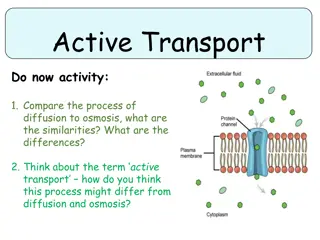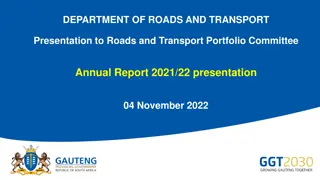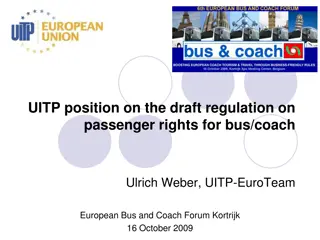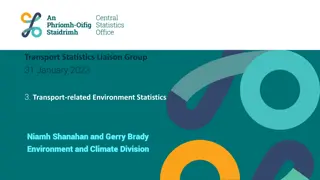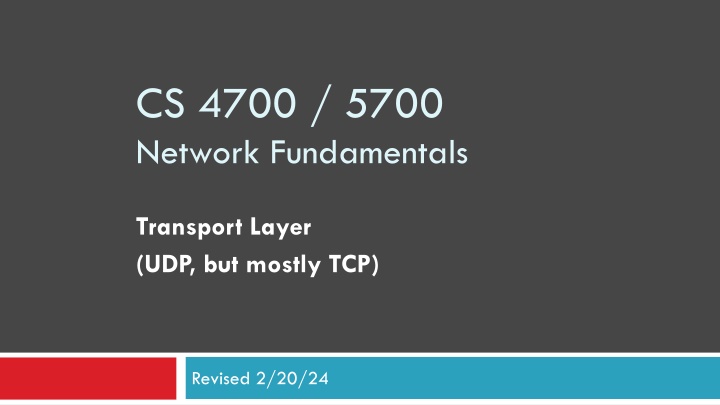
Network Transport Layer Functions and Protocols
Explore the key functions and protocols of the network transport layer, focusing on demultiplexing, error detection, congestion control, TCP header format, UDP protocol, and multiplexing to enhance your knowledge of network fundamentals.
Download Presentation

Please find below an Image/Link to download the presentation.
The content on the website is provided AS IS for your information and personal use only. It may not be sold, licensed, or shared on other websites without obtaining consent from the author. If you encounter any issues during the download, it is possible that the publisher has removed the file from their server.
You are allowed to download the files provided on this website for personal or commercial use, subject to the condition that they are used lawfully. All files are the property of their respective owners.
The content on the website is provided AS IS for your information and personal use only. It may not be sold, licensed, or shared on other websites without obtaining consent from the author.
E N D
Presentation Transcript
CS 4700 / 5700 Network Fundamentals Transport Layer (UDP, but mostly TCP) Revised 2/20/24
Transport Layer 2 Function: Demultiplexing of data streams Application Presentation Session Transport Network Data Link Physical Optional functions: Creating long lived connections Reliable, in-order packet delivery Error detection Flow and congestion control Key challenges: Detecting and responding to congestion Balancing fairness against high utilization
Outline 3 UDP TCP Header Format, Semantics Connection Lifecycle, Sequence Numbers Error Detection and Recovery TCP Options
The Case for Multiplexing 4 Datagram network No circuits No connections Clients run many applications at the same time Who to deliver packets to? Transport Network Data Link Physical IP header protocol field 8 bits = 256 concurrent streams Insert Transport Layer to handle demultiplexing Packet
Server applications communicate with multiple clients Unique port for each application Demultiplexing Traffic 5 Host 1 Host 2 Host 3 Application Transport P1 P2 P3 P4 P5 P6 P7 Network Applications share the same network Endpoints identified by <src_ip, src_port, dest_ip, dest_port>
Layering, Revisited 6 Layers communicate peer- to-peer Host 1 Host 2 Router Application Transport Network Data Link Physical Application Transport Network Data Link Physical Network Data Link Physical Lowest level end-to-end protocol (in theory) Transport header only read by source and destination Routers view transport header as payload
User Datagram Protocol (UDP) 7 0 16 31 Source Port Destination Port Checksum Payload Length Simple, connectionless datagram C sockets: SOCK_DGRAM Port numbers enable demultiplexing 16 bits = 65535 possible ports Port 0 is invalid Checksum for error detection Detects (some) corrupt packets Does not detect dropped, duplicated, or reordered packets
Usage Example 8 No connection , UDP sockets are mostly stateless. One UDP socket may send to many destinations. Sending on a client socket i mpor t s ocket s ock = s ocket . s ocket ( s ocket . AF_I NET , s ocket . SOCK_DGRAM ) s ock. s endt o( mes s age , ( 127. 0. 0. 1 , 3456) ) Receiving on a server socket OS needs to be told what port this application is listening to import socket sock = socket.socket(socket.AF_INET, socket.SOCK_DGRAM) sock.bind(( 0.0.0.0 , 3456)) data, addr = sock.recvfrom(2048) One UDP socket may receive from multiple destinations
UDP Socket Semantics 9 Sending Receiving data, addr = sock.recvfrom(2048) #msg1 data, addr = sock.recvfrom(2048) #msg2 data, addr = sock.recvfrom(2048) #msg3 sock.sendto(msg1, destination) sock.sendto(msg2, destination) sock.sendto(msg3, destination) UDP Header Datagram 1: Src Prt Dst Prt msg1 Datagram 2: Src Prt Dst Prt msg2 Datagram 3: Src Prt Dst Prt msg3
UDP Socket Semantics 10 Sending a buffer will produce exactly one datagram containing the data from the buffer Warning: UDP datagrams may hold up to 65,000 bytes of data If len(UDP datagram) > MTU, IP will need to fragment it Receiving will return exactly one, full datagram Not a partial datagram, not >1 datagrams
Uses for UDP 11 Invented after TCP Why? Not all applications can tolerate TCP Custom protocols can be built on top of UDP Reliability? Strict ordering? Flow control? Congestion control? Examples RTMP real-time media streaming (e.g. voice, video) uTP microtransport protocol used by BitTorrent QUIC app-level transport protocol developed by Google to speed up HTTP
Outline 12 UDP TCP Header Format, Semantics Connection Lifecycle, Sequence Numbers Error Detection and Recovery TCP Options
Transmission Control Protocol 13 Reliable, in-order, bi-directional byte streams Port numbers for demultiplexing Virtual circuits (connections) Flow control Congestion control, approximate fairness 0 Source Port 4 16 31 Destination Port Sequence Number Acknowledgement Number Flags Checksum HLen Advertised Window Urgent Pointer Options
TCP Header Fields 14 0 4 16 31 Used to detect out of order, duplicate, and missing packets Source Port Destination Port Sequence Number Acknowledgement Number Flags Checksum HLen Advertised Window Urgent Pointer Header length. Default length is 20 bytes, but may be longer with options. Options Used for flow control (protecting the receiver from overloading) Used for connection establishment (SYN), acknowledgement (ACK), connection close (FIN), and errors (RST). Not used.
Usage Example TCP is stateful, connections must be formed One TCP socket only sends over one connection 15 Sending on a client socket import socket sock = socket.socket(socket.AF_INET, socket.SOCK_STREAM) sock.connect(( 127.0.0.1 , 3456)) sock.sendall( message ) OS needs to be told what port this application is listening to Receiving on a server socket import socket sock = socket.socket(socket.AF_INET, socket.SOCK_STREAM) sock.bind(( 0.0.0.0 , 3456)) sock.listen() conn, addr = sock.accept() data = conn.recv(2048) Socket listens for incoming connections Accept spawns a second socket
TCP Socket Semantics 16 Sending sock.send(msg1) sock.send(msg2) sock.send(msg3) TCP Header Segment 1: Segment 1: Segment 1: Src Prt Src Prt Src Prt Dst Prt Dst Prt Dst Prt msg1 msg1 + msg2 + msg3 msg1 + msg2a Segment 2: Segment 2: Src Prt Src Prt Dst Prt Dst Prt msg2 msg2b + msg3 Segment 3: Src Prt Dst Prt msg3
TCP Socket Semantics 17 Sending Receiving data = sock.recv(2048) sock.send(msg1) sock.send(msg2) sock.send(msg3) msg1 msg2 msg3
TCP Socket Semantics 18 Sending a buffer may produce any number of segments In practice, TCP tries to optimize by putting close to 1460 bytes in each segment But this is not true under all circumstances Receiving may return any number of data bytes Could return part of a segment Or a full segment Or multiple segments
Connection setup, a.k.a. the three-way handshake Establish connection state Data transfer Sequence numbers for reliable, in-order delivery Perform flow control Connection close Free resources 1. 2. 3. Phases of TCP 19
Connection Setup 20 Why do we need connection setup? To establish state on both hosts Most important state: sequence and acknowledgement numbers Count the number of bytes that have been sent Initial value chosen at random Why? Important TCP flags (1 bit each) SYN synchronization, used for connection setup ACK acknowledge received data FIN finish, used to tear down connection
Three Way Handshake 21 Client Server Seq # C Ack# ? Seq # Ack # S C+1 Why C+1 S+1 Sequence # +1? S+1 C+1 Each side: Notifies the other of starting sequence number ACKs the other side s starting sequence number (+1) Sequence # must increment on receiving a SYN
Why Random Initial Sequence Numbers? 22 Connection confusion How to disambiguate connections from the same host? Random sequence numbers Preventing packet injection How Kevin Mitnick hacked into the SDSC Need good random number generators! Connection state management Each SYN allocates state on the server SYN flood is a common denial of service attack Solution: SYN cookies
Connection setup, a.k.a. the three-way handshake Establish connection state Data transfer Sequence numbers for reliable, in-order delivery Perform flow control Connection close Free resources 1. 2. 3. Phases of TCP 23
Data Transfer 24 TCP uses a byte stream abstraction Initial, random values selected during setup Each byte in each stream is numbered 32-bit value, wraps around Byte stream broken down into segments (packets) Size limited by the Maximum Segment Size (MSS, typically 1460 bytes) Set to limit fragmentation Each segment has a sequence number 13450 14950 16050 17550 Byte stream to send Segment 8 Segment 9 Segment 10
Bidirectional Communication 25 Client Server Seq # 7 Ack# 23 Seq # 23 Ack # 7 23 1467 Problem: this depicts a stop-and-wait protocol Will not be able to utilize all available bandwidth 1467 753 753 2927 Data and ACK in the 2927 same packet 993 Each side of the connection can send and receive Different sequence numbers for each direction
Review from Layer 2: Stop and Wait Protocol 26 Simplest form of reliability Example: Bluetooth Sender Receiver Problems? Low utilization: can only have one segment in flight at any time Timeout 10Gbps link and 10ms delay Need 100 Mb to fill the pipe Assume packets are 1500B 1500B * (8b/1B) / 2 = 6000b = 0.006Mb Utilization is 0.006% Timeout
Review from Layer 2: Sliding Window 27 Allow multiple outstanding, un-ACKed segments Number of un-ACKed segments is called the window Sender Receiver Window Made famous by TCP
Flow Control 28 Problem: how big should the window be? Too many packets may overwhelm the receiver Size of the receiver's buffers may change over time Solution: advertised window Receiver tells the sender how big their buffer (the window) is For window size n, sender may transmit n bytes without receiving an ACK After each ACK, the window slides forward Advertised window may go to zero!
Flow Control: View from the Sender Side 29 Packet Received Packet Sent Src. Port Dest. Port Src. Port Dest. Port Sequence Number Sequence Number Acknowledgement Number Flags Checksum Must be buffered until ACKed Acknowledgement Number Flags Checksum HL Adv. Window Urgent Pointer HL Adv. Window Urgent Pointer sock.send() Buffer of Bytes to Send ACKed Sent To Be Sent Outside Window Window
Sliding Window Example 1460 1460 1460 1460 1460 1460 1460 Buffer of Bytes to Send Window = 3* MSS Client Server Seq # 7 Ack# 23 Seq # 23 Ack # 7 23 1467 23 2927 1467 23 23 4387 2927 23 23 5847 4387 23 23 7307 23 8767 30
What Should the Receiver ACK? 31 ACK every packet Use cumulative ACK, where an ACK for sequence n implies ACKS for all k < n Use negative ACKs (NACKs), indicating which packet did not arrive Use selective ACKs (SACKs), indicating those that did arrive, even if not in order SACK is an actual TCP extension 1. 2. 3. 4. 31
Sequence Numbers, Revisited 32 32 bits, unsigned Why so big? To avoid acknowledgement ambiguity in the window you need |Sequence # Space| > 2 * |Sending Window Size| 232 > 2 * 216
Ambiguous Window Example Imagine that sequence numbers are 1-bit Segments are numbered zero or one Assume window size = 3 segments Client Which segment was acknowledged? 33
Connection setup, a.k.a. the three-way handshake Establish connection state Data transfer Sequence numbers for reliable, in-order delivery Perform flow control Connection close Free resources 1. 2. 3. Phases of TCP 34
Connection Tear Down 35 Client Server Either side can initiate tear down Other side may continue sending data Half open connection shutdown() Acknowledge the last FIN Sequence number + 1
Error Detection 37 Checksum detects (some) packet corruption Computed over IP header, TCP header, and data Corrupt packets are dropped Sequence numbers catch sequence problems Duplicates are ignored Out-of-order packets are reordered or dropped
Out-of-Order (OoO) Delivery Example Assume windows size = 3, all segments contain 1460 bytes of data Assume OoO segments are buffered by the receiver Ack # only increments in order Client Server Seq # 7 Ack# 23 Seq # 23 Ack # 7 Duplicate ACK 23 1467 <Seq # 2927> 23 1467 1467 23 23 4387 1467 23 23 5847 4387 23 Windows does not slide, no transmission Ack # catches up by two segments Window slides by two segments 23 7307 23 8767 38
Packet Loss Example Assume windows size = 3, all segments contain 1460 bytes of data Assume OoO segments are buffered by the receiver Ack # only increments in order Client Server Seq # 7 Ack# 23 Seq # 23 Ack # 7 Duplicate ACK 23 1467 <Seq # 2927> 23 1467 1467 23 1467 23 23 1467 Window does not slide, no transmission 1467 23 39
Client Server Seq # 7 Ack# 23 Seq # 23 Ack # 7 23 1467 <Seq # 2927> 23 1467 1467 23 1467 23 23 1467 1467 23 Timeout, retransmit 23 5847 5847 23 Window slides by three segments 40
Error Detection 41 Checksum detects (some) packet corruption Computed over IP header, TCP header, and data Corrupt packets are dropped Sequence numbers catch sequence problems Duplicates are ignored Out-of-order packets are reordered or dropped Lost segments detected by sender Use timeout to detect lost segments and missing ACKs Need to estimate RTT to calibrate the timeout Sender must keep copies of all data until ACK
Retransmission Time Outs (RTO) 42 Problem: time-out is linked to round trip time Timeout is too short RTO RTO What about if timeout is too long?
Round Trip Time Estimation 43 RTT Sample Original TCP round-trip estimator RTT estimated as a moving average new_rtt = (old_rtt) + (1 )(new_sample) Recommended : 0.8-0.9 (0.875 for most TCPs) RTO = 2 * new_rtt (i.e. TCP is conservative)
RTT Sample Ambiguity 44 RTO RTO Sample? Sample Karn s algorithm: ignore samples for retransmitted segments
TCP Options 45
Common TCP Options 46 0 4 16 31 Source Port Destination Port Sequence Number Acknowledgement Number Flags Checksum HLen Advertised Window Urgent Pointer Options Window scaling Timestamp SACK: selective acknowledgement Maximum segment size (MSS)
Utilization, Revisited 47 Sequence numbers are 32 bits, advertised windows are 16 bits The most data that can be in flight in parallel is 2^16 bytes Recall that link capacity is measured by the bandwidth delay product bandwidth * delay = capacity What is the maximum bandwidth TCP can utilize? 100 ms of delay 2^16 bytes / 100 ms ~ 5 Kbps 500 ms of delay 2^16 bytes / 500 ms ~ 1 Kbps But ethernet scales to 1 Gbps, 10 Gbps, 100 Gbps
Window Scaling 48 Problem: the advertised window is only 16-bits Effectively caps the window at 65536 bytes, 64 KB Solution: introduce a window scaling value scaled_adv_wnd = adv_wnd << wnd_scale; Maximum shift is 14 bits, 1GB maximum window
Sequence Number Scaling 49 Problem: sequence numbers are only 32 bits Effectively caps the window at 2^32 ~ 4 GB What is the maximum bandwidth TCP can utilize? 100 ms of delay 2^32 bytes / 100 ms ~ 344 Mbps 500 ms of delay 2^32 bytes / 500 ms ~ 69 Mbps Solution: the PAWS algorithm 32-bit timestamp option in TCP header When was the packet sent (approximately) Effectively extends the sequence numbers space to 64 bits
SACK: Selective Acknowledgment 50 Problem: duplicate ACKs only tell us about 1 missing packet Multiple rounds of dup ACKs needed to fill all holes Solution: selective ACK Include received, out-of-order sequence numbers in TCP header Explicitly tells the sender about holes in the sequence







